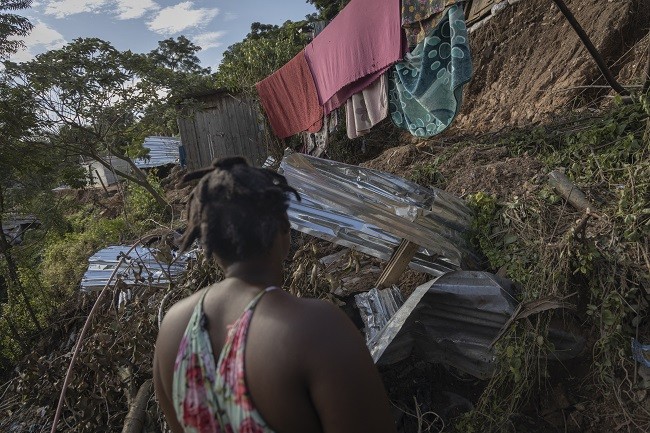Catastrophic Floods Reveal Housing Crisis In South Africa
Thulisile Ntobela used to live in an apartment, but when her rent increased by 25%, she could no longer afford it and had to move out.
She acquired a plot of land in Durban and built a shack on it.
That was five years ago, and it was a lot less expensive than paying rent, which had risen to 200 rand ($12.80) at the time.
“We relocated here because we couldn’t afford to pay our rent.” “All you have to do is build your house and stay,” she explained.
Hers was one of 87 dwellings — corrugated iron shacks — that vanished in seconds as the land at the informal community of eNkanini, on a hilltop residential area in central Durban, was over-saturated with flood water and crumbled.
“I was terrified at the time.” My baby was in my arms. “People were shouting,” the 31-year-old, who was carrying her eight-month-old son, remembered.
No one was hurt since they had already sought refuge at a neighbor’s house when the floor began to sway.
The eNkanini village, which was established in 2016, is now littered with hundreds of shacks, some of which are painted in vibrant colors.
“We don’t have a place to call home.” Mzwandile Hlatshwayo, 25, a community leader, stated, “This is our home.”
According to 2019 government figures, about 13% of South Africa’s 59 million people live in shacks, often known as informal settlements.
Hlatshwayo comes from KwaZulu-rural Natal’s areas, but he traveled to Durban, the province’s largest city, in quest of job.
He’d like to live in government housing, but there isn’t any in the city.
“I came here to look for work. He stated, “There are no jobs in rural areas.”
– Apartheid legacy – According to Sbu Zikode, the head of the land and housing action organization Abahlali baseMjondolo, the problem of landlessness dates back to the apartheid era, which segregated black Africans and people of color, barring them from owning land (shack dwellers).
Poor blacks were evicted from their homes and forced to relocate to less desirable areas.

Despite the fact that apartheid was abolished nearly three decades ago, land allocation and economic inequalities remain unresolved.
According to a UN report from 1995, the housing backlog was anticipated to reach 1.5 million units.
According to the Centre for Affordable Housing Finance in Africa, despite the construction of more than three million government dwellings since then, the shortage has grown to 3.7 million homes.
“We don’t have land or homes because we choose not to,” Zikode explained.
People have also moved to cities in quest of better jobs, healthcare, and education. Infrastructure in cities such as Durban hasn’t kept up with the surge, according to Zikode.
As a result, informal communities have sprung up on idle land. Communities on more valued land, on the other hand, face eviction, which often results in violent clashes, according to Zikode.
“It is for this reason that people will occupy unsafe land.” They’ll take over riverbanks and floodplains.”
The less favorable floodplain places have now also resulted in fatalities.
Poor infrastructure and a lack of concern for the topography, according to rescuers looking for the missing, put the dwellings in jeopardy. Many of those who remain in eNkanini are perched half a metre from cliff edges, susceptible to further storms.
Unpaved walkways up to houses near the top of the hill are treacherously slippery with sand and debris, with pipes exposed, wires downed, and unpaved footpaths up to residences near the top of the hill are treacherously slick with sand and debris.
Officials from the government housing department announced last week that they were clearing ground in the nearby Ndwedwe town to create temporary accommodation for the flood victims, who claimed 435 lives.
Longer-term alternatives are still being researched.
Zikode sees the tragedy as a chance for the government to finally confront landlessness and poverty.
“The country and the rest of the globe are watching to see how we cope with the current crisis,” he remarked.
“The government must now act and give alternative land,” says the author.





